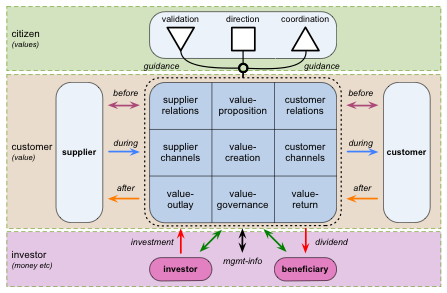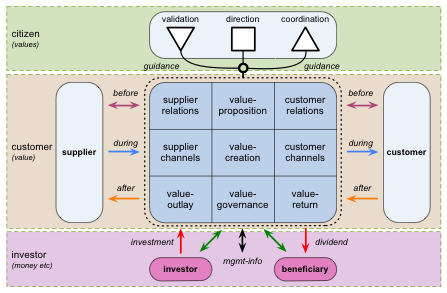A services-checklist for digital-transformation
Blog: Tom Graves / Tetradian
Digital-transformation is most likely to succeed when it’s based on principles of service-design and service-management. The following transformation-checklist can be applied to all forms and modes of service-delivery – not just IT-based, but any appropriate combinations of people, machines and IT.
For a brief overview of this checklist and its context, see the YouTube videos ‘Digital transformation: a services-based checklist – Episode 78, Tetradian on Architectures‘ and ‘Digital-transformation is human-first – Episode 77, Tetradian on Architectures‘.
For a service-framework that can be applied consistently for every type of service, for any content or context, and at any scope or scale, see the blog-series on the ‘Services and Enterprise Canvas review‘. That framework is based on the Enterprise Canvas service-concept:
(To make things easier for IT service-managers, we’ve shown how to link this checklist to familiar standards such as ITIL 2011. Note that ITIL is a proprietary standard: compliance with ITIL copyright-restrictions and licensing-rules may apply, particularly when moving down into the details of ITIL-based service-management. For more information, see the Axelos website, https://www.axelos.com/best-practice-solutions/itil )
1. Service strategy
Do we have clarity on how concepts of service will apply throughout organisational strategy?
Many of these themes will be familiar to service managers, through standards such as ITIL Service Strategy volume. Note, though, that this can often extend far beyond IT, in that everything in the enterprise either is, represents or implies a service. We also need to explore the linkages between strategy, tactics, operations, change, learning and more, as per the generic governance-model described earlier.
2. Service design
Do we have clarity on how to design and redesign services that match the organisation’s changing needs?
Some of the key themes for this, such as service-catalogues, service-availability, service-levels and suchlike, will be familiar to service managers through standards such as the ITIL Service Design volume. Again, though, this applies not just to IT-based services, but to all types of services, and the interactions between them. It also applies to handovers and substitutions between service-types, such as in switching over to an equivalent manual process during disaster-recovery. Note also that this applies to design for how smaller-scope services can aggregated into larger-scope services, and for dynamically-constructed services and processes specific to each customer’s needs.
3. Service transition
Do we have clarity on how to change our services, to match the organisation’s changing needs, without disrupting service operations?
The key themes for this will be familiar to service managers via standards such as the ITIL Service Transition volume – though these will, again, usually need to be extended to cover a scope much broader than IT alone. One further theme to consider here is how service-transition intersects with service-operations – such as where software-updates may be deployed automatically many times per day, or where services are changed on-the-fly for specific customers or for A/B-testing and the like.
4. Service operation
Do we have clarity on how our services are operating, in terms of delivering to enterprise needs?
The key themes for this can be found in service-management standards such as the ITIL Service Operation volume, with concerns such as reliability, efficiency, incident-capture and so on, but also about capture of insights and ideas for improvement that arise from within the process of operations itself. Once again, this must also apply to all types of service-delivery and service-operations – not solely to IT-services.
5. Continual service improvement
Do we have clarity on how to support continual improvement of services?
This builds on themes that should be familiar to most service managers through standards such as the ITIL Continual Service Improvement volume. The key concern here is to ensure that these principles are actively applied in real-world practice – not just talked about as a good idea!
6. Service value management
Do we have clarity on how to ensure that services keep on-track to enterprise values?
For service managers, some aspects of this would be addressed via standards such as the ITIL Service Design, Service Operation and Continual Service Improvement volumes – but often there’ll also be much, much more. For example, whilst this would include IT-related aspects of security management, financial management and suchlike, an organisation will also need to cover enterprise-wide value-concerns such as health and safety, financial-probity, environment, sustainability, customer-engagement, trust, anticlient-issues and many others. For each of these enterprise-values, you’ll need distinct support services that explain why that value is important in the enterprise; provide training and skills-development in how to support that value within every action; provide run-time tracking of factors relevant to that value; and guide continuous-learning from the outcomes of every action. The respective set of enterprise-values would be derived from the enterprise-story: identifying these is a key first step in any business-transformation.
7. Service management for transformation
Do we have clarity on how to address the complexities of business-transformation?
For service managers, this draws some of its themes from standards such as the ITIL Service Design volume, but extends to address the far greater complexities of digital-transformation. One example here relates to the classic quality-concern of ‘garbage in, garbage out’: both big-data and machine-learning can actually be dangerous if the data they rely on are of questionable quality. The success of that business-transformation would thus depend not just on the respective technologies, but also the quality-assurance services for all of the data-sources that feed into those systems.
Leave a Comment
You must be logged in to post a comment.









